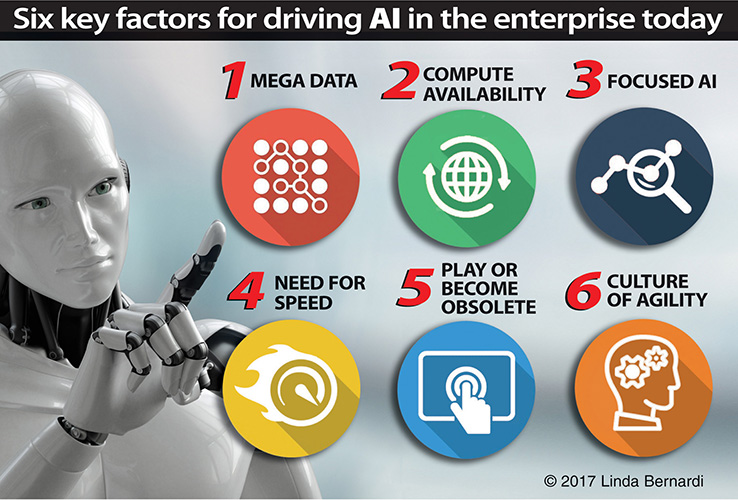Why is Enterprise AI so HOT Now?


It is due to the confluence of six factors:
1. Mega Data
2. Compute Availability
3. Focused AI
4. Need For Speed
5. Play or become obsolete
6. Culture of Agility
There has never been a more exciting time for artificial intelligence in enterprises. In working with enterprises of various sizes in different verticals across the globe, I see a convergence of these six key driving factors for AI in the enterprise today. Yet AI is not a new concept. Why now?
The reasons are discussed in detail in my upcoming book, The Inversion Factor (MIT Press, October 2017), but I will unpack some of them here. They include:
1. We are past Big Data (which occurred with the advent of mobile, apps and social media), and are in the Hyper-Data stage. With the hyper-connected world of the Internet of Things (IoT) growing at an exponential rate, we will see data volumes and a need for action on a scale we have not seen before. There will be billions of new devices with multiple sensors, resulting in terabytes of fresh, actionable data. We need to think mindfully about how to handle this unprecedented volume of data. It will require AI and machine learning (ML).
2. Today, enterprises of any size have access to extremely fast processors via providers such as NVIDIA (and other providers designed specifically for AI), as well as access to unlimited cloud computing capability at low costs. Processor speed, geography and access to applications are no longer issues. Not only is cost now manageable, but AI enabled hardware is readily available, along with many AI apps and libraries. Hardware and software no longer pose any limitations. In parallel, applications are being designed to be user friendly and accessible, which means companies no longer need huge teams of engineering prodigies to start deploying AI across their data. AI deployment is being rapidly simplified.
3. Instead of Generalized AI, we are now looking at Narrow AI—or what I call Focused-AI, designed for specific tasks involving Hyper-Data. In other words, goal is not to spend years building out AI and ML capabilities or prove that the machine can think like a human. Rather, it is to create enabling and narrowly focused AI applications targeted for specific uses. This is a key enabler to speedy AI deployment in enterprises. Critical game changing startups are emerging on the enterprise AI scene, facilitating the speed of enterprise AI deployment. The challenge for enterprises is to identify the ‘right’ and ‘best’ startups to collaborate with, and not buy the marketing hype! AI is not magic.
4. Unlike the past of enterprise computing, where computing paradigms could take years to design and deploy, competitive pressures are forcing enterprises to become truly agile in order to remain relevant and competitive. If we look at customer experience as one use-case that applies to all verticals, the need to be constantly connected and respond to customers in real-time is a significant driver for this change. Another example is IoT and the emerging hyper-connected world, not to mention autonomous vehicles. Now, millions of inter-connections have to function in real time.
5. Being part of the hyper-connected world is not an option. Rather, it is a reality for all enterprises. Leaders need to think mindfully about AI deployment and become part of connected world fabric—or risk becoming irrelevant.
6. The culture of this new world revolves around experimentation, fail-fast, the willingness change on a dime, making big bets, and agile, adaptive thinking. The old rules will not work. Culture change is key. There is a lot of uncertainty, which will require a culture willing to constantly iterate and evolve. This new culture needs to inspire and reward those in the enterprise who help promote this mission.
I am encouraged, but I see gaps that can be addressed via the following:
First, mindfully determining goals, not deploying AI across the board and hoping to succeed. This is not a fishing expedition or amped-up-analytics. It is the first time we can use AI to advance enterprise computing to the next level.
Second, more cautiously funding startups. The AI field is cluttered with startups; some are simply analytics companies in an AI wrapper in the form of automated trend analysis utilities. Yet venture capital is funding them all. Remember the Internet bubble? Right now there is too much venture money and too few great ideas. The noise and hype is overwhelming enterprises that want to invest in AI but are confused.
Do your homework. Find the winner AI companies. Separate them from the non-AI startups. Today there are many large tech players and systems integrators offering solutions as well. I advise all my enterprise clients and colleagues to take care to distinguish between intelligent/automated analytics and true AI/ML.
Conclusion and Insight: The ultimate goal of AI is to predict things we did not know, change processes which would have been impossible before, and understand data in a way that was previously impossible. We want to see what we have not seen before and find connections that are impossible for humans to deduce. We want to evolve our businesses, anticipate new approaches, and thrive in the emerging hyper connected world.
These six elements show the way.
Disrupt | Innovate | Lead
© All rights reserved – Linda Bernardi

